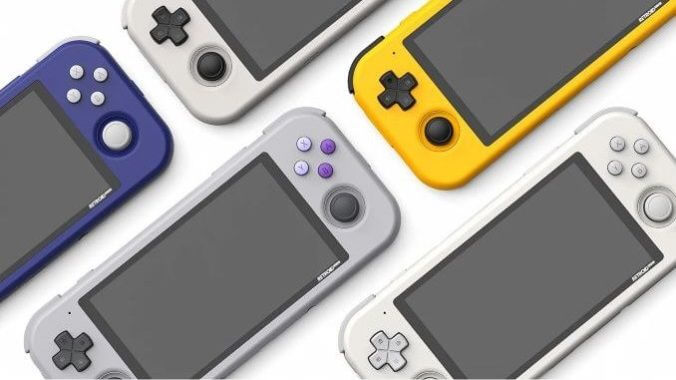A Beginner’s Guide to Retro Gaming Handhelds
Images courtesy of Retroid
I consider myself a relatively savvy consumer, and typically don’t fall for targeted ads online—but there was something about the onslaught of those retro gaming handheld emulators that kept catching my eye. They just looked so fun. All those old Mario Bros. and Sonic the Hedgehog games in your pocket? Plus PS1 classics like Metal Gear Solid or Need For Speed? All for a hundred bucks or so? Yeah, that’s enticing.
They’re small, cheap, colorful and loaded with just enough hardware and software tricks to put all the old videogames you loved as a kid (or adult, no judgment here!) in the palm of your hand. They even come in a whole lot of different shapes and sizes, ranging from everything to Game Boy-esque to something more in line with a Nintendo Switch.
So, after getting sucked into a few videos on TikTok and Twitter ads, I started doing a bit of research to figure out the potential options and which one might be right for what I wanted to do. Turns out, there are a lot of options. Not to mention the fact that none of this is actually all that easy to do, at least for an average person without a ton of expertise in the minutia of various emulators, ROMS and all the settings tweaks and work it takes to make those things work together smoothly in a little handheld device.
There’s a reason Nintendo charges a premium for its Nintendo Switch, and why Sony made you pay a high price for its PSP handheld of yore: There’s something to be said about the simplicity of pick up and play, and sometimes it can be worth paying for it.
My own research into the retro gaming handheld scene ended with the purchase of a Retroid Pocket 3 (a relatively popular option in this ecosystem), which cost around $120 and can emulate most games ranging from the Genesis and SNES era all the way up through the PS1, N64 and Sega Dreamcast. Yes, you can rock a Crazy Taxi session in the palm of your hand, and it is pretty glorious when it works.
That said, it wasn’t an easy journey to get it all working, and it still remains frustratingly complicated at times. I spent the better part of a weekend going down the rabbit hole of set-up guides, YouTube walk-throughs and myriad Reddit threads with folks asking a lot of the questions I had until I finally got it up and running. For most of these handhelds (the majority of which run Android), you have to add the relevant emulators, locate your own digital copies of games (files called ROMs) and follow all the directions for naming conventions and folder hierarchies to ensure your particular handheld can access and recognize them all. Plus, you have to actually acquire the ROM files for the games, which can be a legally dubious exercise in itself.
Along the way, I had to do a full reset of my Retroid Pocket 3 because of a bizarre crash loop, though it didn’t take awfully long to set it back up, since I’d just spent the better part of a Saturday figuring out how to do it all the first time around. Then I had to figure out which emulators worked best for the types of games and systems I wanted to run, though thankfully most of these products make that easy enough on set-up to walk you through the nitty-gritty. Is it worth the effort? Sure. Once it’s all said and done, these things can be crazy handy. I had a marathon day in a hospital waiting room recently, and it proved a lifesaver to provide a few hours of distraction. Just be prepared to invest some time in getting it all up and running, and all the frustration that can bring.
So where should you start if considering a handheld to revisit some of your favorite old school games? There are plenty of options, but I’ve highlighted five of the best ones below, broken down from cheapest to most expensive, as well as based on their respective capabilities and ease of use. The starting options are borderline stocking stuffer prices, while the top end will run you around what a Playstation 5 might cost.
Funkey S
$69.99
Want something small, cool, relatively cheap and a whole lot of fun? The Funkey S more than fits the bill. Its shape and aesthetic is right out of the old school Game Boy wheelhouse (just with a clamshell design), and as you’d suspect, it can effortlessly emulate Game Boy, Game Boy Advance, Sega Genesis, Super NES and even some Playstation 1 games. It’s one of the least-powered options available, but also among the cheapest. The best part? It’s tiny enough to literally fit on your keychain, making it an imminently useful little gadget to have on hand for anytime you’re waiting in line, on a short commute, or just generally bored. It only gets around one to two hours of battery life, but considering its tiny size and full color screen, that’s no surprise. This is arguably more of a novelty option, but an incredibly fun one for the price point.
-

-

-

-

-

-

-

-

-

-

-

-

-

-

-

-

-

-

-

-

-

-

-

-

-

-

-

-

-

-

-

-

-

-

-

-

-

-

-

-








































